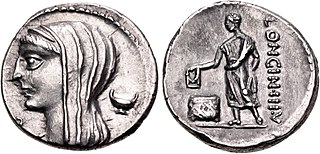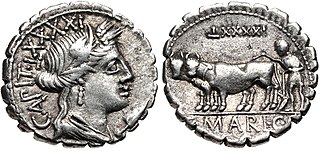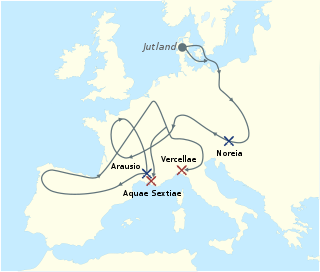Births
| | This section is empty. You can help by adding to it. (May 2021) |
| Millennium: | 1st millennium BC |
|---|---|
| Centuries: | |
| Decades: | |
| Years: |
| 107 BC by topic |
| Politics |
|---|
| Categories |
Year 107 BC was a year of the pre-Julian Roman calendar. At the time it was known as the Year of the Consulship of Ravilla and Marius (or, less frequently, year 647 Ab urbe condita ) and the Fourth Year of Yuanfeng. The denomination 107 BC for this year has been used since the early medieval period, when the Anno Domini calendar era became the prevalent method in Europe for naming years.
| | This section is empty. You can help by adding to it. (May 2021) |

This article concerns the period 49 BC – 40 BC.
80s BC is the time period from 89 BC – 80 BC.

This article concerns the period 109 BC – 100 BC.

Year 42 BC was either a common year starting on Monday, Tuesday or Wednesday or a leap year starting on Tuesday of the Julian calendar and a common year starting on Tuesday of the Proleptic Julian calendar. At the time, it was known as the Year of the Consulship of Lepidus and Plancus. The denomination 42 BC for this year has been used since the early medieval period, when the Anno Domini calendar era became the prevalent method in Europe for naming years.
Year 86 BC was a year of the pre-Julian Roman calendar. At the time it was known as the Year of the Consulship of Cinna and Marius/Flaccus. The denomination 86 BC for this year has been used since the early medieval period, when the Anno Domini calendar era became the prevalent method in Europe for naming years.
Year 82 BC was a year of the pre-Julian Roman calendar. At the time it was known as the Year of the Consulship of Marius and Carbo. The denomination 82 BC for this year has been used since the early medieval period, when the Anno Domini calendar era became the prevalent method in Europe for naming years.

Gaius Marius was a Roman general and statesman. Victor of the Cimbric and Jugurthine wars, he held the office of consul an unprecedented seven times. He was also noted for his important reforms of Roman armies. He set the precedent for the shift from the militia levies of the middle Republic to the professional soldiery of the late Republic; he also improved the pilum, a javelin, and made large-scale changes to the logistical structure of the Roman army.

The gens Cassia was a Roman family of great antiquity. The earliest members of this gens appearing in history may have been patrician, but all those appearing in later times were plebeians. The first of the Cassii to obtain the consulship was Spurius Cassius Vecellinus, in 502 BC. He proposed the first agrarian law, for which he was charged with aspiring to make himself king, and put to death by the patrician nobility. The Cassii were amongst the most prominent families of the later Republic, and they frequently held high office, lasting well into imperial times. Among their namesakes are the Via Cassia, the road to Arretium, and the village of Cassianum Hirpinum, originally an estate belonging to one of this family in the country of the Hirpini.

The Jugurthine War was an armed conflict between the Roman Republic and king Jugurtha of Numidia, a kingdom on the north African coast approximating to modern Algeria. Jugurtha was the nephew and adopted son of Micipsa, king of Numidia, whom he succeeded on the throne, overcoming his rivals through assassination, war, and bribery.
Cassius Longinus may refer to:

Gaius Marius "the Younger" was a Roman republican general and politician who became consul in 82 BC with Papirius Carbo. He fought in Sulla's civil war. He committed suicide that same year at Praeneste, after his defeat by Sulla and during the city's capture by Quintus Lucretius Afella.

Lucius Cassius Longinus was consul of the Roman Republic in 107 BC. His colleague was Gaius Marius, then serving the first of his seven consulships.
Marcus Terentius Varro Lucullus, younger brother of the more famous Lucius Licinius Lucullus, was a supporter of Lucius Cornelius Sulla and consul of ancient Rome in 73 BC. As proconsul of Macedonia in 72 BC, he defeated the Bessi in Thrace and advanced to the Danube and the west coast of the Black Sea. In addition, he was marginally involved in the Third Servile War.
Gaius Norbanus Flaccus was a Roman politician and general during the 1st century BC.
Lucius Cornelius Merula was a politician and priest of the late Roman Republic.
Lucius Caecilius Metellus Delmaticus was a Roman politician and general. He was a son of Lucius Caecilius Metellus Calvus and brother of Quintus Caecilius Metellus Numidicus. He was consul in 119 BC; during his year, he opposed Gaius Marius' election procedures law. As consul and proconsul from 119–117 BC, he campaigned against the Dalmatians. For his victories, he triumphed in 117 BC, earning his cognomen and dedicating two temples – also contributing to repairs for the Temple of Castor and Pollux – from the spoils of war.

The gens Maria was a plebeian family of Rome. Its most celebrated member was Gaius Marius, one of the greatest generals of antiquity, and seven times consul.

The Battle of Burdigala was a battle of the Cimbrian War that occurred in the year 107 BC. The battle was fought between a combined Germanic-Celtic army including the Helvetian Tigurini under the command of Divico, and the forces of the Roman Republic under the command of Lucius Cassius Longinus, Lucius Caesoninus, and Gaius Popillius Laenas. Longinus and Caesoninus were killed in the action and the battle resulted in a victory for the combined tribes.

The gens Norbana was a plebeian family at ancient Rome. Members of this gens are first mentioned toward the beginning of the first century BC, and from then to the end of the second century AD they filled a number of magistracies and other important posts, first in the late Republic, and subsequently under the emperors.